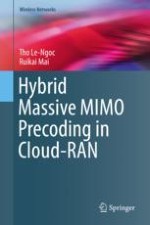2019 | OriginalPaper | Chapter
6. Nonlinear Hybrid Precoding for Massive MIMO with Universal Frequency Reuse
Authors : Tho Le-Ngoc, Ruikai Mai
Published in: Hybrid Massive MIMO Precoding in Cloud-RAN
Publisher: Springer International Publishing
Activate our intelligent search to find suitable subject content or patents.
Select sections of text to find matching patents with Artificial Intelligence. powered by
Select sections of text to find additional relevant content using AI-assisted search. powered by
